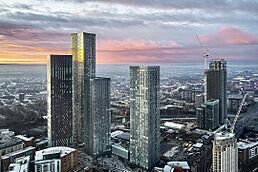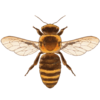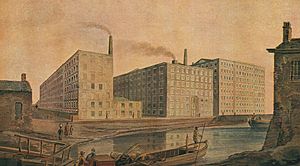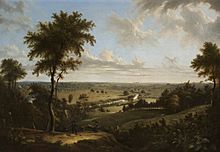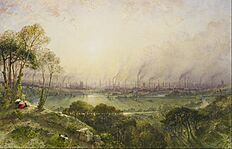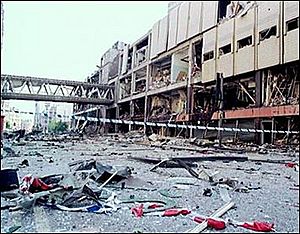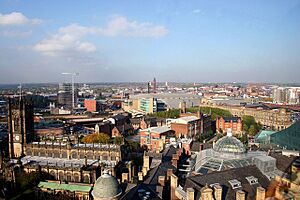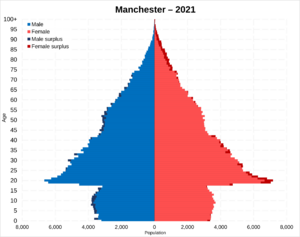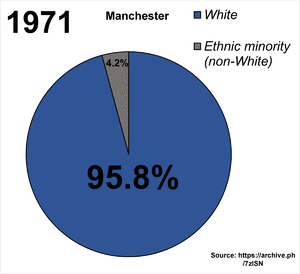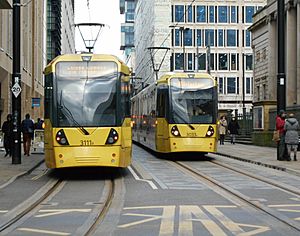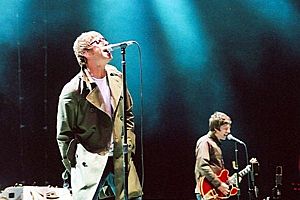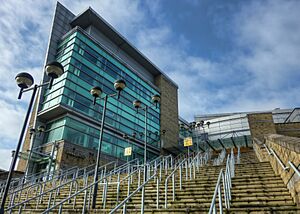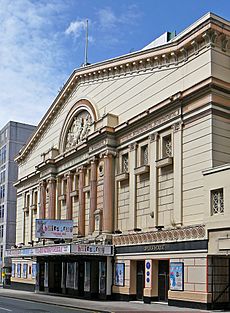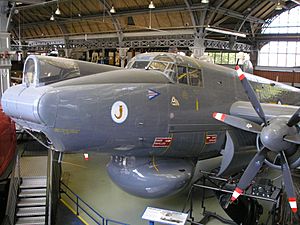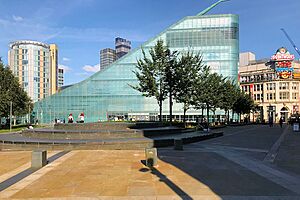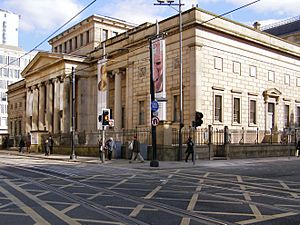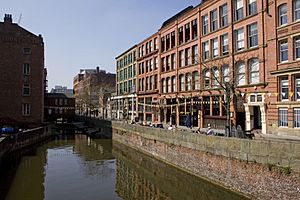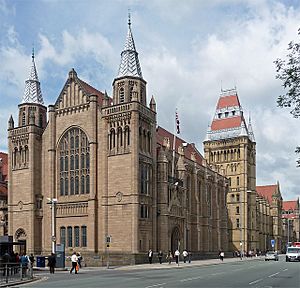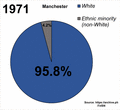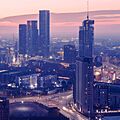Manchester facts for kids
Quick facts for kids
Manchester
|
|||
|---|---|---|---|
|
Skyline of Deansgate Square
Manchester Central Library
|
|||
|
|||
Nickname(s):
|
|||
| Motto(s): | |||
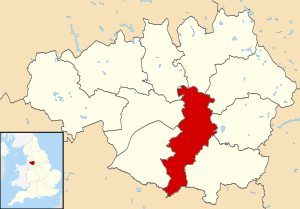
Manchester shown within Greater Manchester
|
|||
| Sovereign state | United Kingdom | ||
| Country | England | ||
| Region | North West | ||
| Ceremonial county and city region | Greater Manchester | ||
| Founded | 1st century AD | ||
| Town charter | 1301 | ||
| City status | 29 March 1853 | ||
| Metropolitan borough | 1 April 1974 | ||
| Administrative HQ | Manchester Town Hall | ||
| Government | |||
| • Type | Metropolitan borough | ||
| • Body | Manchester City Council | ||
| Area | |||
| • Total | 44.6 sq mi (115.6 km2) | ||
| Area rank | 204th | ||
| Population
(2005 est.)
|
|||
| • Total | 552,858 | ||
| • Rank | 5th | ||
| Demonym(s) |
|
||
| Ethnicity (2021) | |||
| • Ethnic groups |
List
|
||
| Religion (2021) | |||
| • Religion |
List
36.2% Christianity
32.4% no religion 22.3% Islam 1.1% Hinduism 0.6% Buddhism 0.5% Sikhism 0.5% Judaism 0.5% other 5.9% not stated |
||
| Time zone | UTC+0 (GMT) | ||
| • Summer (DST) | UTC+1 (BST) | ||
| Postcode area |
|
||
| Dialling code | 0161 | ||
| ISO 3166 code | GB-MAN | ||
| GSS code | E08000003 | ||
Manchester is a large city and metropolitan borough in Greater Manchester, England. It is one of the biggest cities in the United Kingdom. In 2005 est., about 552,858 people lived there. The wider Greater Manchester area has over 2.9 million people. Manchester is surrounded by the Cheshire Plain to the south and the Pennines mountains to the north and east. The city of Salford is to its west.
The story of Manchester began around 79 AD. A Roman fort called Mamucium was built on a sandstone hill. This was near where the River Medlock and River Irwell meet. For many centuries, Manchester was a small town. But in the 1800s, it grew very fast. This was because of the Industrial Revolution and the boom in textile making. Manchester became the world's first industrial city.
Manchester became a city in 1853. The Manchester Ship Canal opened in 1894. This canal connected the city to the Irish Sea, about 36 miles (58 km) away. After the Second World War, the city faced tough times as industries changed. A large bomb attack in 1996 led to a lot of rebuilding. Manchester then hosted the 2002 Commonwealth Games.
The city is famous for its amazing buildings, lively culture, and music. Many important scientific discoveries happened here. For example, Ernest Rutherford first split the atom in 1917 at the University of Manchester. Also, the world's first stored-program computer was developed here in 1948. In 2004, Andre Geim and Konstantin Novoselov first found graphene in Manchester.
Contents
- What's in a Name? The Origin of Manchester
- A Look Back: Manchester's History
- Exploring Manchester's Geography
- Who Lives in Manchester? Demographics
- Manchester's Economy: A Hub of Activity
- Iconic Sights: Manchester's Landmarks
- Getting Around: Transport in Manchester
- Manchester's Vibrant Culture
- Learning in Manchester: Education
- Sports in Manchester: A City of Champions
- News and Entertainment: Media in Manchester
- Global Connections: Twin Cities
- Images for kids
- See also
What's in a Name? The Origin of Manchester
The name Manchester comes from the old Latin name Mamucium. People from Manchester are still called Mancunians. This Latin name likely came from an older Brittonic (Celtic) word. Some think it might come from *mamma*, meaning "mother," possibly referring to a local river goddess. The ending -chester comes from an Old English word meaning "Roman fort." This shows the city's Roman past.
Manchester is often called "the capital of the North" in England.
A Look Back: Manchester's History
How Manchester Began: Early History
The Brigantes were a major Celtic tribe in northern England. They had a stronghold where Manchester Cathedral now stands. In 79 AD, the Roman General Agricola ordered a fort called Mamucium to be built. This protected Roman interests in other cities. People have lived in central Manchester ever since. You can still see parts of the Roman fort's foundations in Castlefield.
The Romans left Manchester around the 3rd century. After the Romans, the main settlement moved to where the Irwell and Irk rivers meet. In 1086, Manchester was mentioned in the Domesday Book. By 1421, a collegiate church was built, which is now Manchester Cathedral. Next to it is Chetham's Library, which opened in 1653. It is the oldest free public library in the UK.
Manchester became a market town by 1282. Around the 14th century, weavers from Flanders came to Manchester. This helped start the region's textile industry. By 1540, Manchester was a busy town known for making wool and linen.
During the English Civil War, Manchester supported the Parliament. Oliver Cromwell even gave it the right to elect its own Member of Parliament.
Cotton started to be used a lot after 1600. By 1750, pure cotton fabrics were made. The Irwell and Mersey rivers were made easier to travel on by 1736. This opened a route from Manchester to the sea. The Bridgewater Canal, Britain's first man-made waterway, opened in 1761. It brought coal from mines to Manchester. These improvements made coal and cotton cheaper. Manchester became the main place for trading textiles. In 1780, Richard Arkwright built Manchester's first cotton mill. In the early 1800s, John Dalton developed his atomic theory here.
The Industrial Revolution: A City Transformed
Manchester was a key center for making textiles during the Industrial Revolution. It was once the most productive place for processing cotton.
Manchester became known as the world's biggest market for cotton goods. It was called "Cottonopolis" and "Warehouse City." The Industrial Revolution caused Manchester's population to grow very quickly. People came from all over the UK and Ireland for work. By 1835, Manchester was the "first and greatest industrial city in the world."
Many different industries grew in Manchester. Engineering companies made machines for the cotton trade. The chemical industry made dyes and bleaches. Financial services like banking also grew.
The growing city needed good transport. The canal system was expanded. Manchester became one end of the world's first intercity passenger railway. This was the Liverpool and Manchester Railway. In 1878, the first telephones in Manchester were provided to a company.
The Manchester Ship Canal was built between 1888 and 1894. It was 36 miles (58 km) long. This allowed large ships to sail right into the Port of Manchester. The world's first industrial estate, Trafford Park, was created on the canal's banks.
Manchester was a center of new ideas. It saw new industrial processes and new ways of thinking. It attracted educated visitors from all over Europe. A famous saying was, "What Manchester does today, the rest of the world does tomorrow." Manchester's best time was probably the late 1800s. Many grand public buildings, like Manchester Town Hall, were built then.
However, the Industrial Revolution also brought poverty. Historian Simon Schama said Manchester was "the very best and the very worst taken to terrifying extremes."
The number of cotton mills in Manchester reached 108 in 1853. After that, the number started to go down. But Manchester grew as a financial center for the region. In 1913, 65% of the world's cotton was processed in the area. The First World War affected trade. Other parts of the world started processing more cotton. Manchester suffered greatly during the Great Depression.
World War II and Beyond
During the Second World War, Manchester played a big part. Factories switched to making bombs and aircraft engines. Because of this, Manchester was a target for bombing by the German air force (Luftwaffe). The biggest attacks happened in December 1940. A large part of the city center was destroyed. Many buildings, including Manchester Cathedral, were badly damaged.
After the war, cotton processing continued to decline. The port of Manchester closed in 1982. Heavy industry also slowed down from the 1960s.
The city began to rebuild in the late 1980s. New projects included the Manchester Metrolink tram system and the Bridgewater Hall concert venue. Manchester also tried to host the Olympic Games twice.
On 15 June 1996, a large bomb exploded in the city center. This caused huge damage to buildings. It led to a massive rebuilding project for Manchester.
Manchester in the 21st Century
After the 1996 bombing and with the help of the 2002 Commonwealth Games, Manchester's city center was greatly improved. New places like The Printworks and Corn Exchange became popular for shopping and entertainment. The Manchester Arndale is the UK's largest city-center shopping mall.
Many old buildings have been updated or replaced with modern glass and steel structures. Old mills have become apartments. The 47-story Beetham Tower was the tallest building outside London when it was finished in 2006. It was later surpassed by the 201-meter (659-foot) South Tower of the Deansgate Square project in 2018.
On 22 May 2017, a bomb attack happened at an Ariana Grande concert in the Manchester Arena. This tragic event caused many deaths and injuries. It led to widespread sadness and changed the UK's threat level.
Exploring Manchester's Geography
Manchester is located about 160 miles (257 km) northwest of London. It sits in a bowl-shaped area. The Pennines mountains are to the north and east. The Cheshire Plain is to the south. The city center is on the east bank of the River Irwell. It is a relatively low-lying area. The River Mersey flows through the south of Manchester.
The flat inner city offers great views of the Pennines. These mountains can be covered in snow in winter. Manchester's geography was very important for its early growth as an industrial city. This included its climate, its closeness to the port of Liverpool, waterpower from its rivers, and nearby coal.
The name Manchester is officially for the metropolitan district. But it is often used for the wider Greater Manchester area. For example, the "Manchester post town" covers a larger area.
Manchester is the most populated part of the Greater Manchester Urban Area. This is the UK's third-largest group of connected towns and cities. The city has a mix of busy urban areas and quieter suburbs. The largest park is Heaton Park, covering about 610 acres (247 ha).
Manchester's Climate: What to Expect
Manchester has a temperate oceanic climate. This means it has warm summers and cold winters. Summer daytime temperatures often reach 20 °C (68 °F) and sometimes 25 °C (77 °F) in July and August. Sometimes, temperatures can even go above 30 °C (86 °F).
It rains regularly throughout the year, but usually not too heavily. The city gets about 806.6 mm (31.76 in) of rain each year. This is less than the UK average. Manchester also has high humidity. This, along with plenty of soft water, helped the textile industry grow. Snow is not common in the city center because of the "urban warming effect." However, the nearby Pennine Moors get more snow.
Who Lives in Manchester? Demographics
Manchester's population grew very fast during the Victorian era. It reached its highest point of 766,311 people in 1931. After that, the population went down. This was due to clearing old, poor housing and building new social housing estates outside the city.
In 2012, Manchester's population was estimated at 510,700. This was a 1.6% increase from 2011. Since 2001, the population has grown by 20.8%. Manchester was the third fastest-growing area in the 2011 census. The city's population is expected to reach 532,200 by 2021.
Manchester has a younger population compared to Greater Manchester and England. There are many people aged 20–35. In the 2011/2012 school year, there were over 76,000 students at Manchester's universities.
Religious Diversity in Manchester
Religious beliefs, according to the 2021 census Christian (36.2%) No Religion (32.4%) Muslim (22.3%) Hindu (1.1%) Buddhist (0.6%) Jewish (0.5%) Other (0.5%) Religion Not Stated (5.9%)
According to the 2021 census, Manchester has a diverse mix of religions.
- 36.2% of people are Christian.
- 32.4% have no religion.
- 22.3% are Muslim.
- Smaller numbers follow Hinduism, Buddhism, Sikhism, and Judaism.
Greater Manchester has the largest Jewish population in Britain outside London.
Manchester's Ethnic Makeup
Manchester is a very diverse city. The 2011 census showed that:
- 66.7% of the population was White.
- 17.1% were Asian.
- 8.6% were Black.
- 4.7% were of mixed race.
- 1.9% were Arab.
- 1.2% were of other ethnic backgrounds.
Areas like Moss Side and Chinatown are home to many different ethnic groups. Manchester has one of Europe's largest Irish Festivals, including a St Patrick's Day parade. The city's Chinatown has many Chinese restaurants and shops. Manchester also attracts many Chinese students, making it home to the third-largest Chinese population in Europe.
Manchester's Economy: A Hub of Activity
Manchester's economy is strong and growing. The wider metropolitan area is the third largest in the UK. It is known as a "beta world city," meaning it's an important global city.
Manchester's leaders are known for their business skills. The city owns two of the UK's busiest airports. It uses the money earned from them to fund local projects. In 2012, Manchester had the 9th lowest tax cost for businesses among industrial cities worldwide. It was also Europe's most affordable city in a cost-of-living report.
Manchester is a city of contrasts. It has both very wealthy and less wealthy neighborhoods. In 2010, Manchester was ranked the 4th most deprived local council in England. Unemployment was higher than the national average in 2012–2013. However, Greater Manchester has more multi-millionaires than any place outside London. In 2013, Manchester was ranked 6th in the UK for quality of life among large cities.
Women in Manchester earn better compared to men than in the rest of the country. Also, 37% of working-age people in Manchester have university degrees.
Manchester has the largest office market in the UK outside London. Many companies are moving jobs from the South of England to Manchester. This is because office space is cheaper and there are many skilled workers.
Iconic Sights: Manchester's Landmarks
Manchester's buildings show many different styles, from Victorian to modern. Many buildings are made of red brick. This reminds us of the city's past as a cotton trade center. Outside the city center, many old cotton mills have been turned into apartments and offices. Manchester Town Hall in Albert Square is built in the Gothic revival style.
Manchester also has many tall buildings. The Beetham Tower was the tallest outside London when it was finished in 2006. It has a Hilton hotel and apartments. The tallest skyscraper now is Deansgate Square South Tower, at 201 meters (659 feet). One Angel Square is one of the most sustainable large buildings in the world.
Heaton Park is one of Europe's largest city parks. It covers 610 acres (247 ha). The city has 135 parks and open spaces.
Manchester has many public statues. Albert Square has monuments to Prince Albert and others. Piccadilly Gardens has statues of Queen Victoria and famous inventors. The Manchester Cenotaph in St Peter's Square remembers those who died in wars. The Alan Turing Memorial in Sackville Park honors the "father of modern computing." A statue of Abraham Lincoln was given to the city to recognize Lancashire's role during the American Civil War. A Concorde airplane is on display near Manchester Airport.
Manchester has six special local nature reserves. These include Chorlton Water Park and Boggart Hole Clough.
Getting Around: Transport in Manchester
Rail Travel in Manchester
Manchester Liverpool Road railway station was the world's first railway station built just for passengers and goods. It was the end point for the Liverpool & Manchester Railway, the world's first inter-city passenger railway. The building is still there and is part of the Science & Industry Museum.
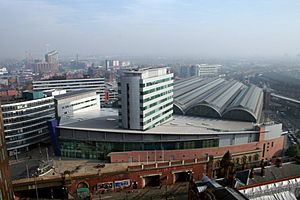
Today, Manchester has a good rail network. It includes the West Coast Main Line. The two main stations are Manchester Piccadilly and Manchester Victoria. The Manchester stations are the third busiest in the UK.
Trams: The Metrolink System
Manchester was the first UK city to get a modern tram system. The Manchester Metrolink opened in 1992. In 2016–2017, over 37 million journeys were made on the trams. The system has eight lines and 99 stops. A new line to the Trafford Centre opened in 2020.
Buses: Connecting the City
Manchester has one of the largest bus networks outside London. Over 50 bus companies operate in the Greater Manchester region. In 2011, 80% of public transport journeys in Greater Manchester were by bus. Free buses, called Manchester Metroshuttle, run on three routes around the city center.
Air Travel: Manchester Airport
Manchester Airport serves Manchester and the wider North of England. It is the third busiest airport in the UK. It has flights to many places in Europe, North America, Africa, the Middle East, and Asia. A second runway opened in 2001. The airport can handle the world's largest planes, like the Airbus A380.
A smaller airport, City Airport Manchester, is west of the city center. It was Manchester's first airport. Today, it is used for private flights and flight training.
Canals: A Historic Network
Manchester has a large canal network, including the Manchester Ship Canal. These were built for carrying goods during the Industrial Revolution. Today, the canals are mostly used for leisure.
Manchester's Vibrant Culture
Music: The Sound of Manchester
Manchester is famous for its music scene. Many popular bands started here, including Oasis, the Smiths, Joy Division, and New Order. Manchester was a key city for British indie music in the 1980s. This included bands like the Stone Roses and Happy Mondays. This period was known as "Madchester" and centered around The Haçienda nightclub.
Manchester's main pop music venue is Manchester Arena. It is the largest arena of its kind in Europe. Other venues include Manchester Apollo and Manchester Academy. Manchester has the most indie and rock music events outside London.
Manchester has two symphony orchestras, The Hallé and the BBC Philharmonic. It also has a chamber orchestra, the Manchester Camerata. Manchester is a great place for music education. It has the Royal Northern College of Music and Chetham's School of Music. The main classical music venue is the Bridgewater Hall.
Brass band music is also important to Manchester's musical history. Some of the UK's top bands are from Manchester.
Performing Arts: Theatre and Dance
Manchester has a lively theatre, opera, and dance scene. Large venues like Manchester Opera House and the Palace Theatre host big touring shows. The Royal Exchange Theatre is the largest theatre in the round in the UK.
Smaller venues include the Contact Theatre. The Dancehouse is dedicated to dance. In 2014, HOME, a new arts complex, opened. It has two theatre spaces, five cinemas, and an art exhibition space.
Since 2007, Manchester has hosted the Manchester International Festival. This festival focuses on new and original art. In 2023, the festival moved to its permanent home, Aviva Studios.
Museums and Galleries: Discovering Manchester's Past
Manchester's museums celebrate its Roman past and its industrial heritage. They also cover its role in the Industrial Revolution, the textile industry, and football. You can see a reconstructed part of the Roman fort in Castlefield.
The Science and Industry Museum is in the old Liverpool Road railway station. It has old steam engines, machines, and a copy of the world's first computer program. The Museum of Transport shows historic buses and trams. Imperial War Museum North is in nearby Trafford Park. The Manchester Museum has collections of Egyptology and natural history.
Other museums include the National Football Museum and the People's History Museum.
The Manchester Art Gallery has a collection of European paintings. It also has one of Britain's main collections of Pre-Raphaelite paintings. The Whitworth Art Gallery shows modern art and textiles. It was named Museum of the Year in 2015. The works of painter L. S. Lowry, known for his "matchstick" paintings, can be seen in several galleries.
Literature: Manchester's Storytellers
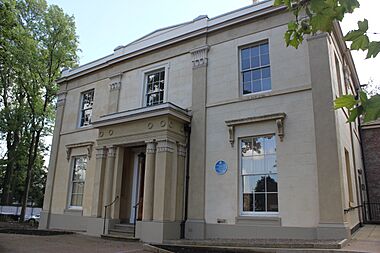
Manchester is a UNESCO City of Literature. It is known for its "radical literary history." In the 1800s, Manchester appeared in books about the changes brought by industry. These include Elizabeth Gaskell's novel Mary Barton (1848). Friedrich Engels wrote The Condition of the Working Class in England in 1844 while living here.
Karl Marx and Engels met at Chetham's Library. This library was founded in 1653 and is said to be the oldest public library in the English-speaking world. The John Rylands Library has a large collection of early printed books. It displays the Rylands Library Papyrus P52, believed to be the oldest New Testament text.
Charles Dickens is thought to have based his novel Hard Times partly on Manchester. Elizabeth Gaskell wrote most of her novels at her home in 84 Plymouth Grove. She hosted famous authors like Dickens and Charlotte Brontë.
Charlotte Brontë started writing Jane Eyre in 1846 while staying in Hulme. She was with her father, who was recovering from eye surgery. Isabella Banks, a Victorian novelist, is famous for her 1876 novel The Manchester Man. Frances Hodgson Burnett, author of The Secret Garden, was born in Cheetham Hill.
Anthony Burgess wrote his famous book A Clockwork Orange in Manchester in 1962. Dame Carol Ann Duffy, a former Poet Laureate, lives in West Didsbury.
Nightlife: Fun After Dark
Manchester's night-time economy has grown a lot since 1993. There are over 500 licensed places in the city center. They can host more than 250,000 visitors. On a typical weekend night, 110,000–130,000 people visit. This makes Manchester a very popular city for events. The night-time economy is worth about £100 million and supports 12,000 jobs.
The "Madchester" music scene of the 1980s was based around clubs like The Haçienda. This period was shown in the movie 24 Hour Party People.
The Gay Village: A Welcoming Community
The pubs in the Canal Street area have been popular with the LGBTQ+ community since at least 1940. This area is now the center of Manchester's LGBTQ+ community. It attracts 20,000 visitors every weekend. It also hosts a popular festival called Manchester Pride every August.
Learning in Manchester: Education
Manchester has three universities:
- University of Manchester
- Manchester Metropolitan University
- Royal Northern College of Music
The University of Manchester is the second largest university in the UK. It was formed in 2004 by combining two older universities. It includes the Manchester Business School, which offered the UK's first MBA course in 1965.
Manchester Metropolitan University started in 1970 and became a university in 1992. The three universities are located around Oxford Road. This area is Europe's largest higher-education district. Together, they have over 80,000 students.
One famous secondary school is Manchester Grammar School. It was founded in 1515. Other notable schools include William Hulme's Grammar School and Withington Girls' School.
Sports in Manchester: A City of Champions
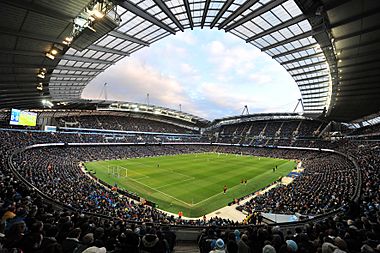
Manchester is home to two major Premier League football clubs: Manchester City and Manchester United. Manchester City plays at the City of Manchester Stadium in east Manchester. This stadium was built for the 2002 Commonwealth Games. Manchester United's stadium, Old Trafford, is in the nearby area of Trafford. It is next to the Lancashire County Cricket Club ground, also called Old Trafford.
Many sports facilities were built for the 2002 Commonwealth Games. These include the City of Manchester Stadium and the Manchester Aquatics Centre. Manchester tried twice to host the Olympic Games.
The National Cycling Centre has a velodrome and BMX Arena. It is the home of British Cycling. The Manchester Velodrome has helped British cycling become very successful. The National Indoor BMX Arena opened in 2011. The Manchester Arena hosted the FINA World Swimming Championships in 2008. Manchester has also hosted major events in squash, lacrosse, rugby, and cricket.
News and Entertainment: Media in Manchester
Print Media: Newspapers
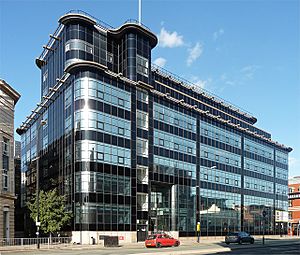
The Guardian newspaper was founded in Manchester in 1821 as The Manchester Guardian. Many national newspapers used to have offices in Manchester. This earned the city the nickname "second Fleet Street." However, most national newspapers moved their operations to London in the 1980s.
The main local newspaper is the Manchester Evening News. It is the largest regional evening newspaper in the UK. It is given out for free in the city center on Thursdays and Fridays.
Television: Broadcasting from Manchester
Manchester has been a center for television broadcasting since the 1950s. Many TV studios have been in the city. Most have now moved to MediaCityUK in nearby Salford.
The ITV company Granada Television has been based in Manchester since 1954. It used to be at Granada Studios on Quay Street. Granada produces Coronation Street and local news for North West England.
The BBC also has a major center in Manchester. In 1954, the BBC opened its first regional TV studio outside London. Famous shows like Top of the Pops were broadcast from here. Many BBC programs were made at New Broadcasting House on Oxford Road.
Radio: Manchester's Airwaves
Manchester has the most local radio stations outside London. These include BBC Radio Manchester, Hits Radio Manchester, and Capital Manchester and Lancashire. Student radio stations like Fuse FM also operate here. Community radio stations cover areas like Ardwick and Wythenshawe.
Global Connections: Twin Cities
Manchester has special "twinning" or "friendship agreements" with several cities around the world. These connections help build relationships and understanding between different cultures.
- Amsterdam, Netherlands (2007)
- Bilwi, Nicaragua
- Chemnitz, Germany (1983)
- Córdoba, Spain
- Faisalabad, Pakistan (1997)
- Los Angeles, United States (2009)
- Rehovot, Israel
- Saint Petersburg, Russia (1962)
- Wuhan, People's Republic of China (1986)
- Osaka, Japan
Manchester has the largest group of consuls in the UK outside London. Consuls are officials who represent their country in another city. This shows Manchester's strong international links.
Images for kids
-
Cotton mills in Ancoats, around 1820.
-
The Peterloo Massacre of 1819 resulted in 15 deaths and several hundred injured.
-
View from Kersal Moor towards Manchester by Sebastian Pether, around 1820. Note the River Irwell in both paintings.
-
Manchester from Kersal Moor, by William Wyld in 1857, a view now dominated by chimney stacks as a consequence of the Industrial Revolution.
-
Oxford Road, one of the main roads into Manchester city centre.
-
The Chinatown Paifang.
-
Manchester Piccadilly railway station, the busiest of the four major railway stations in the Manchester station group.
-
Gaskell House, where Mrs Gaskell wrote most of her novels.
-
The Etihad Stadium is home to Premier League club Manchester City F.C. and host stadium for the 2002 Commonwealth Games.
-
The 1930s Art Deco Express Building on Great Ancoats Street.
-
Granada Studios, the former headquarters of Granada Television.
See also
 In Spanish: Mánchester para niños
In Spanish: Mánchester para niños


